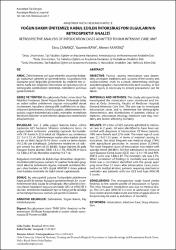YOĞUN BAKIM ÜNİTEMİZE KABUL EDİLEN İNTOKSİKASYON OLGULARININ RETROSPEKTİF ANALİZİ
Özet
AMAÇ: Zehirlenmeye yol açan etkenler yaşanılan bölge-ye, toplumun gelenek ve göreneklerine, sosyoekonomik düzeyine göre değişiklik gösterebilir. Bu nedenle her ül-kenin, hatta her bölgenin zehirlenme ile ilgili etyolojik ve demografik özelliklerinin belirlenip, önlemlerin alınması gerekmektedir. GEREÇ VE YÖNTEM: Bu çalışmada Ordu Üniversitesi Tıp Fakültesi Hastanesi Genel Yoğun Bakım Ünitesinde takip ve tedavi edilen zehirlenme olguları retrospektif olarak incelenerek, hastaların demografik özelliklerinin ve dağı-lımlarının belirlenmesi, klinik bulguları, zehirlenmenin et-yolojisi, yoğun bakımda kalış süresi, mortalite, mortaliteyi etkileyen faktörler ve zehirlenme vakalarının incelenmesi amaçlanmıştır. BULGULAR: Son 2 yılda yoğun bakıma kabul edilen toplamda 625 hastanın 54’ünün zehirlenme tanısı ile yoğun bakım ünitemize yatırıldığı saptandı. Bu hastala-rın% 78’i kadın,% 22’si erkek idi. Olguların yaş ortalaması 22.13±11.33 idi. Zehirlenmeye neden olan madde olarak ise en sık tıbbi ilaçlar (%74) ikinci sırada ise tarım ilaçları (%12.96) yer almaktaydı. Zehirlenme nedeni en sık özkı-yım amaçlı ilaç alımı idi (% 88.88). Yoğun bakıma ilk geliş Glasgow koma skorları (GKS) 13,1±1.95, APACHE II skoru ise 5.88±2.47 idi. Mortalite oranımız %3.7 idi. Bulguların mortalite ile ilişkili olup olmadıkları değerlen-dirildiklerinde başvuru zamanı 12 saatten fazla olan grup, metil alkol ile zehirlenen olgular, mekanik ventilatör ihti-yacı olan hastalar ve GKS düşük APACHE II skoru yüksek olan hastalar mortalite ile ilişkili olarak saptanmıştır. SONUÇ: Bu retrospektif çalışma Türkiye’deki zehirlenme hasta profili ile benzer bulgular göstermektedir. En sık ze-hirlenmeler tıbbi ilaçlar ile olmaktadır. Mortalite belirleyi-cisi olarak hastaların başvuru anındaki GKS ve APACHE II skorları, zehirlenen maddenin tipi ve hangi yol ile alındığı ve hastaneye başvuru zamanı yol gösterici olabilir. OBJECTIVE: Factors causing intoxication vary depen-ding on region, traditions and customs of the society and socioeconomic level. As a result, determining etiologic and demographic characteristics for each country, in fact each region, is necessary to ensure precautions can be taken. MATERIALS AND METHODS: This study retrospectively investigated the intoxication cases monitored and tre-ated at Ordu University, Faculty of Medicine Hospital, General Intensive Care Unit. The aim was to investigate intoxication cases and to determine the demographic characteristics and distributions of patients, clinical sy-mptoms, intoxication etiology, intensive care stay, mor-tality and factors affecting mortality. RESULTS: Of a total of 625 patients admitted to intensi-ve care in 2 years, 54 were identified to have been ad-mitted with diagnosis of intoxication. Of these patients, 78% were female and 22% male. The mean age of cases was 22.13±11.33 years. In terms of material causing in-toxication, the most frequent was medical drugs (74%) with agricultural pesticides in second place (12.96%). The most frequent cause of intoxication was intake with suicidal intent (88.88%). On first admittance to intensive care Glasgow Coma Score (GCS) was 13.1±1.95 and APA-CHE II score was 5.88±2.47. The mortality rate was 3.7%. When correlation of findings to mortality was assessed, there was a correlation identified with the group appl-ying more than 12 hours after intoxication, cases poiso-ned with methyl alcohol, patients requiring mechanical ventilator and patients with low GCS and high APACHE II scores. CONCLUSIONS: This retrospective study found similar findings to the patient profile of intoxication in Turkey. The most frequent intoxication was due to medical dru-gs. The GCS and APACHE II scores at admission, type of toxic material and intake route and time of application to hospital may be used as indicators of mortality.
















